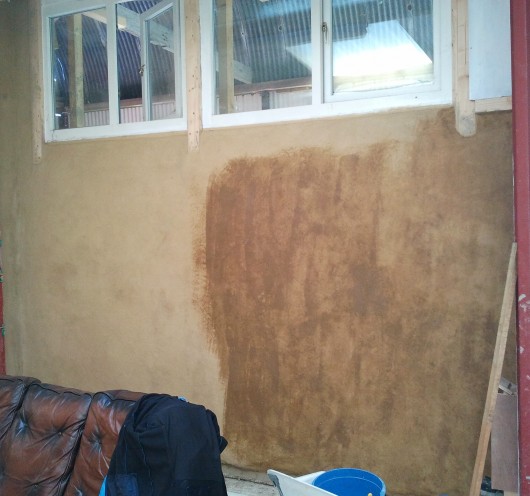12 – Finishing
Finishing your clay plaster
This is where things can really start to diverge, as there are many choices and looks to consider. Perhaps the most important thing to bear in mind when thinking about finishes is maintaining the important qualities of the clay plaster that led you to decide to go down this path. ‘Breathability’ might well have been one of them, in which case you’ll not want to be sealing up the walls behind lots of oils and non-breathable products for instance.
If you’ve put effort/ money/ resources into making the finish plaster coat look special, it’s doubtful you want to go covering it up with paint. In which case something that can harden up the plaster, protect it and prevent dusting would be good. There are a few products out there (see resources) which can do just that without impeding much on breathability. We used a single coat of Earthborn Wall Glaze diluted with 3 parts water on the interior. For the sponged section we then topped it with another coat of undiluted glaze too. We tried this on a patch of the polished wall, but thought that looked a bit too shiney. We’re pretty happy with how the glaze has hardened up the plaster, provided a water resistant layer and stopped any dusting.

If you want to have a painted finish inside, that is pretty easy, there are many natural paints out there these days, including clay paint and limewash can be used inside as well.
If you have outside clay plaster it might well be covered up with weatherscreens etc. It will likely need some protection, and the wall glaze products are specifically for indoor use only. Hence, we are going for limewash on our ‘ambiguously outside sections’, it’s relatively cheap and has been used in the past on cob buildings etc. Plus it will brighten up our semi-outside area and protect it from the dampness.
Another option in this case is silicate paint, there are a few products out there. We’ve seen some sob-stories which put us off somewhat (http://bristolgreenhouse.co.uk/site/render.html), but also we found these products were quite a lot more expensive than limewash, which for something that might not work, we weren’t willing to go for. If you had reason to believe this might be the way forward, perhaps tester pots would be the answer here. The environmental credentials of silicate products versus lime (less energy intensive production and less nasty to deal with) certainly make it worth pursuing if you can.